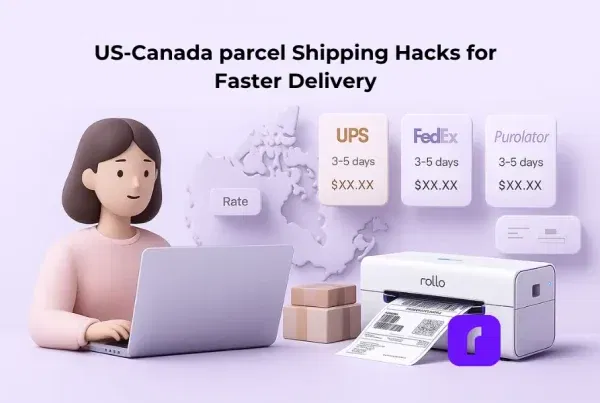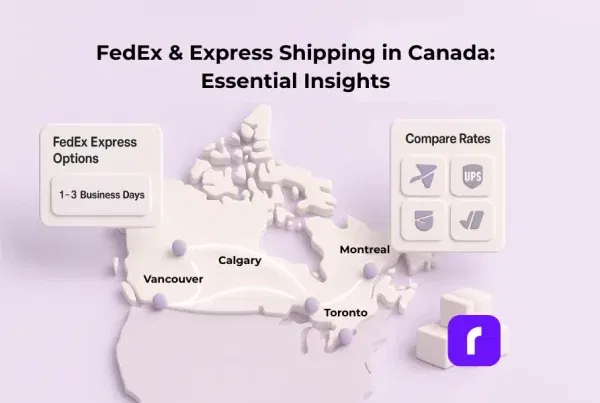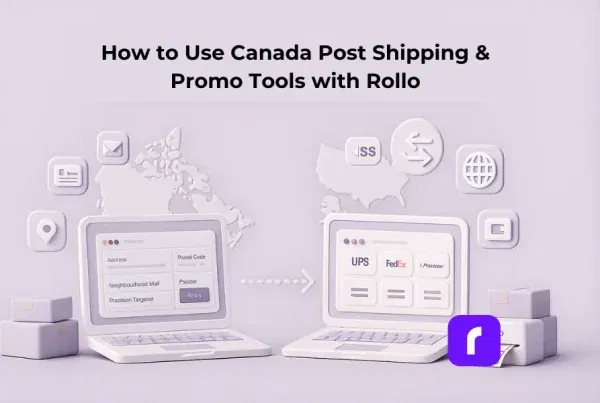Have you ever opened an order, typed its weight into three different carrier sites, and still felt unsure you picked the best price? If so, you know how nerve-racking shipping can be. One wrong click can sink your profit, slow delivery, or both. For online sellers and small shops, that decision isn’t a side task—it’s the line between money earned and money lost. The good news? A few smart shipping rate comparison habits can take the guesswork out of every label you print. This guide walks you through those habits, shows you where hidden costs hide, and explains how tools like Rollo Ship make comparing rates almost effortless.
Key Takeaways
What Is Shipping Rate Comparison—and Why It Matters

Disclaimer: This savings example is illustrative. Individual results will vary based on shipment details and rates available at the time of purchase.
Shipping rate comparison is exactly what it sounds like: comparing prices so that you can ultimately pick the best shipping carrier for your package. That might feel obvious, yet plenty of sellers still skip it, trusting muscle memory (“I always use USPS”) or rough math (“UPS is cheaper for heavy stuff, right?”).
Skipping a quick shipping rate comparison has two big downsides:
- ⚠️ Prices swing constantly. Fuel surcharges rise, holiday fees pop up, and new “economy” services appear without warning.
- 📦 Every package is different. A two-pound candle sent across town may be cheapest with USPS Ground Advantage, while a 12-pound hoodie bundle to the West Coast could favor UPS Ground.
Sellers who compare every shipment report saving 10–30 percent a month—money any small business can use elsewhere.
What Impacts the Cost of Shipping a Package?

Disclaimer: This savings example is illustrative. Individual results will vary based on shipment details and rates available at the time of purchase.
Several moving parts decide the final price that pops up in your cart. Knowing them helps you predict when one carrier will beat another and when it’s time to rethink your packing style.
Weight vs. Size: Two Ways to Pay
Carriers charge by actual weight (what your scale says) or dimensional weight (how much space the box takes up). Dimensional weight, also called volumetric weight, hits hard when a box is large but light—think pillows or a poster tube. If you often ship fluffy or oddly shaped items, measure boxes carefully and keep them as small and tight as you can.
Hidden Fees You Might Miss
Base prices look fine until add-ons sneak in. Residential delivery surcharges, rural route fees, Saturday surcharges, and signature requests can add dollars you didn’t plan for. Fuel surcharges rise and fall with the price of gas. Even retail rates—the default prices at a carrier’s counter—can be higher than the commercial rates you get online or through a shipping app.
Carrier Rules and Service Types
USPS, UPS, and FedEx all have different cut-offs for shapes, cylindrical items, and “oversize” limits. UPS gives a better deal on heavy packages, but USPS Ground Advantage can beat everyone on small boxes going short distances. FedEx One Rate offers a prepaid flat fee if your items fit their branded packaging. Understanding these quirks keeps you from overpaying.
Shipping Rate Comparison Without the Headache

Disclaimer: This savings example is illustrative. Individual results will vary based on shipment details and rates available at the time of purchase.
Comparing rates sounds simple until you’re juggling tabs, ZIP codes, and service charts. Many sellers start by looking up each carrier manually, but that chew-through-your-afternoon method rarely lasts.
Manual Lookups vs. Time-Saving Tools
Manual Lookups (Old Way)
- 📝 Re-enter data for weight, dimensions, and addresses on every site
- ⏳ Copy numbers into a spreadsheet, then do the math yourself
- 😵 Fine for one order—chaos during busy season
Smart Tools (Better Way)
- 🔄 Enter package details once and pull live prices from multiple carriers
- ⏱️ See the cheapest or fastest option instantly—no spreadsheets
- 🏷️ Print a 4 × 6-inch shipping label in one click and get back to work
If your shipping rate comparison tool also offers real-time commercial rates and built-in discounts, that quick compare step becomes a habit that saves money on every shipment, not just the big ones.
What to Look For in a Shipping Rate Comparison Tool
A good rate-comparison platform should do three things well:
- ⏱️ Pull real-time commercial rates from multiple services. If a tool isn’t showing up-to-the-minute USPS and UPS prices, you’re already leaving savings on the table.
- 🏷️ Streamline label creation. Jumping from the rate screen to a separate label printer plug-in kills your workflow. The best tools generate a 4 × 6-inch label in one click.
- 💰 Offer deep discounts with no volume hoops. Steep rates shouldn’t be reserved for sellers who ship hundreds of boxes a day. Look for a platform that passes along commercial pricing—even if you’re shipping your very first order.
Rollo Ship checks all three boxes. It pulls live USPS and UPS rates, sorts them from cheapest to fastest, and lets you print a crisp thermal label in about a second. Better yet, the discounted pricing is baked in—no monthly minimum, no hidden fees, just instant savings each time you click “Buy Label.” One Brooklyn candle shop trimmed its average label cost by 23 percent in the first month after switching, proof that the right tool pays for itself fast.
USPS, UPS, or FedEx? Which Carrier Wins for Your Needs?

Disclaimer: This savings example is illustrative. Individual results will vary based on shipment details and rates available at the time of purchase.
No single carrier wins every shipping rate comparison. The trick is matching package traits to a carrier’s sweet spot.
A Shipping Rate Comparison Side-by-Side Look
| Package Example | USPS Ground Advantage | UPS Ground | FedEx Ground |
|---|---|---|---|
| 2 lb box, Zone 2 | Often cheapest; 2-5 days | Slightly higher; 1-4 days | Similar to UPS; 1-5 days |
| 8 lb box, Zone 6 | Jumps in price due to size | Frequently cheapest; 3-5 days | Close to UPS; 3-5 days |
| 3 lb poster tube | Extra fee for shape | Okay if under 48″ long | Often best rate on tubes |
(Rates change; always check live quotes.)
Cheapest Way to Ship Common Packages
- 📨 Small items under a pound: USPS First-Class Package or Ground Advantage.
- 🏋️ Heavy boxes (10 lb+): UPS Ground tends to win, especially cross-country.
- 🌀 Odd shapes: Measure everything; FedEx often handles tubes and long boxes cheaper.
- 🌍✈️ International parcels under 4 lb: USPS First-Class International is economical but slower; UPS Saver gives speed at a higher cost.
Remember, these patterns aren’t rules. Double-check each shipment in your shipping rate comparison tool.
How Rollo Simplifies Shipping Rate Comparison for SMBs

Disclaimer: This savings example is illustrative. Individual results will vary based on shipment details and rates available at the time of purchase.
Even seasoned sellers can get lost in carrier charts, so Rollo built its platform to keep shipping simple.
Real-Time Rates and Discounted Labels
Rollo Ship talks directly to USPS and UPS servers. When you click “Get Rates,” it fetches live commercial prices—often up to 90 percent lower than retail counter rates—and lists them from cheapest to fastest. There’s no “minimum monthly volume” wall; a weekend hobby seller sees the same discounts a bigger store does.
Print Labels Fast with a Wireless Printer
Once you pick a service, Rollo makes label printing simple and lightning-fast.
Choose between the wireless thermal printer—perfect for printing anywhere without cables—or the USB-connected model for a plug-and-play setup that’s just as powerful. Both print crisp 4×6-inch labels in about a second with no ink, no toner, and no smears. Plus, Rollo’s labels are FSC-certified and BPA-free, so your shipping is cleaner and greener.
By cutting down on label costs, eliminating ink hassles, and speeding up fulfillment, Rollo helps small businesses spend less time printing—and more time growing.
How to Estimate Shipping Costs Before You Buy

Disclaimer: This savings example is illustrative. Individual results will vary based on shipment details and rates available at the time of purchase.
Comparing live quotes is best, but you can predict costs early with a few details in hand.
Info You Need to for an Accurate Shipping Rate Comparison
- 📍 Destination ZIP codes or postal codes
- ⚖️ Package weight down to the ounce (a kitchen scale works)
- 📦 Box dimensions (length, width, height)
- 🚚 Service speed you and the customer expect
Plug those into a shipping calculator—Rollo Ship offers a free one inside the dashboard—and you’ll see a price range before you even pack the order.
Flat-Rate vs. Calculated Shipping Rate Comparison
Flat-rate boxes can be a lifesaver for heavy items in small cartons. USPS Priority Flat Rate Large Box, for instance, ships up to 70 lb for a single price, often beating calculated rates for dense, compact goods. But if your package is light or oddly shaped, calculated pricing tied to weight and dimensions usually wins. Always do a quick side-by-side check.
Ready to Compare Rates and Cut Your Shipping Costs?
Unlock live commercial USPS & UPS prices, lightning-fast 4×6 labels, and automatic tracking updates—all in one easy dashboard.
Final Words: Smarter Shipping Starts with Better Comparisons
A shipping rate comparison doesn’t have to feel like rolling the dice. When you understand how weight, size, and sneaky fees shape the final cost—and when you lean on tools that automate the math—you keep more profit in your pocket and more time in your day. Rollo Ship puts live rates, deep discounts, and lightning-fast label printing in one place, so you can focus on growing your store instead of wrestling spreadsheets.
Ready to stop guessing and start saving? Try Rollo Ship today and see how much you can cut from your next batch of orders.
Follow Rollo on:
Frequently Asked Questions About Shipping Rate Comparisons
📌 Q: How do I use a shipping calculator to compare shipping rates from multiple carriers?
💭 A: A good shipping calculator lets you enter package weight, dimensions, destination ZIP codes or postal codes, then shows real-time prices from major carriers side by side so you can pick the best deal in seconds.
📌 Q: What drives shipping costs up besides actual weight?
💭 A: Carriers often price by dimensional or volumetric weight, add fuel surcharges, and charge extra for special handling or oversized boxes, so the final price is rarely based on actual weight alone.
📌 Q: Is USPS Ground Advantage really cheaper than UPS Ground or FedEx Ground?
💭 A: For small, light boxes traveling short zones, USPS Ground Advantage usually wins; once a shipment gets heavier or larger, UPS Ground or FedEx Ground can offer more cost-effective rates—always compare options before buying.
📌 Q: What’s the cheapest way to ship heavy packages or rigid packaging?
💭 A: For 20 lb+ or rigid packaging, UPS Ground often provides the cheapest way to ship, but double-check with a calculator because applicable discounts and pre-negotiated rates can flip the result.
📌 Q: Can small business owners get discounted rates without high volume?
💭 A: Yes. Many platforms pass along commercial shipping discounts—no need to be a high-volume shipper—so even a side-hustle seller can unlock affordable shipping options.


